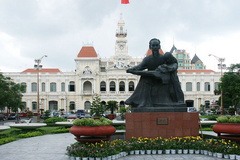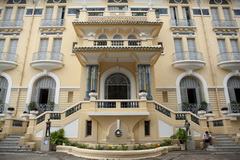




Located at number 161/85/20, Lac Long Quan Street, District 11, Giac Vien is one of the oldest temples in Ho Chi Minh City. At first, it only used to be a warehouse while another pagoda (named Giac Lam) was being rebuilt. After the renovation of the latter was completed, Giac Vien Pagoda was...

Location and history Dai Nam Park is considered as Vietnam’s top man-made tourism spot, which boasts a mix of modern and traditional architectures. An entertainment complex in Binh Duong, on National Highway No. 13, the park was officially brought into use in late 2008. It’s about...

The People’s Committee Building of Ho Chi Minh City is located at one end of Nguyen Hue Street, one of the most beautiful streets in this metropolis. The building was built and put into use in 1909 as a hotel whose original name was Hôtel de Ville. It was designed by...

La poste centrale (Buu Dien) constitue un témoignage important de l'architecture française au Vietnam, ce qui explique sa position de monument incontournable d'Ho Chi Minh-Ville.Fondée entre 1886 et 1891, ce bel immeuble rappelle les constructions parisiennes. Ainsi,...

Le musée des Beaux-Arts (Bao Tang My Thuat) se donne à voir dans une belle demeure particulière au n° 97 de la rue Pho Duc Chinh, au sud du centre ville. Il s'agit en effet d'un édifice Art Déco, orienté selon les règles du Feng Shui,...

Situé au 28, rue Vo Van Tân, dans le 3e arrondissement, ce musée a été créé en septembre 1975. Dans un premier temps, il était la Maison d’exposition des crimes de guerre et de résistance contre les Américains. Ce...

Située dans l’arrondissement de Thu Duc sur une superficie de 20 ha, Suôi Tiên est l'une des zones de loisirs les plus populaires pour les habitants de Hô Chi Minh-Ville. Cet endroit a été construit en s'inspirant des animaux sacrés des...

The resplendent Governor's Palace, completed in 1875, symbolized the regime's political power in Asia. And five years later, the Duc Ba (Our Lady's) Cathedral was inaugurated, and became the spiritual and cultural crucible of the French presence in the OrientCet ouvrage a...

Giac Lam is one of the oldest pagodas in Ho Chi Minh City. Originally, it was built by Ly Thuy Long – a native Minh Huong, in 1744, as a gathering place during Lunar New Year. The new-built temple was like a scenic lookout overlooking Gia Dinh Market while the area was still undeveloped and...

Le marché Bên Thành est situé au cœur du 1er arrondissement. Sa construction a débuté en 1912 et s'est achevée en mars 1914. Il a fait l'objet d'une restauration en 1985. Mais la surface du marché et la tour de...

Soyez le premier à connaître nos offres de voyage exclusives et les nouveaux circuits !.